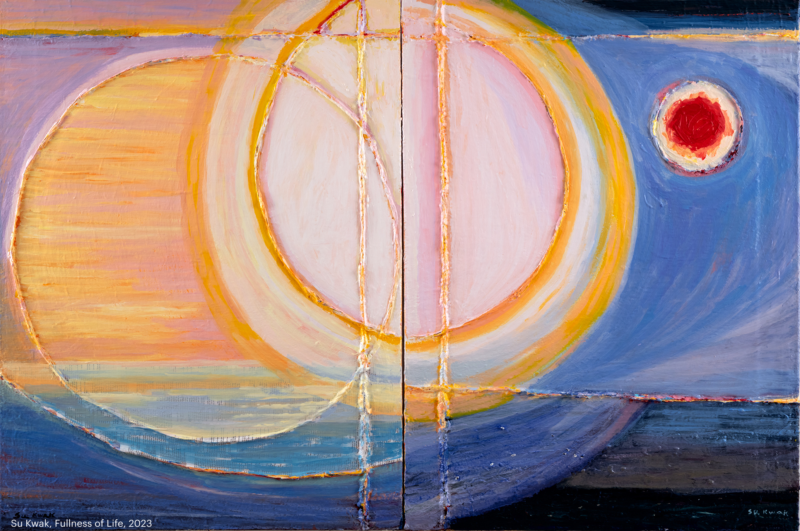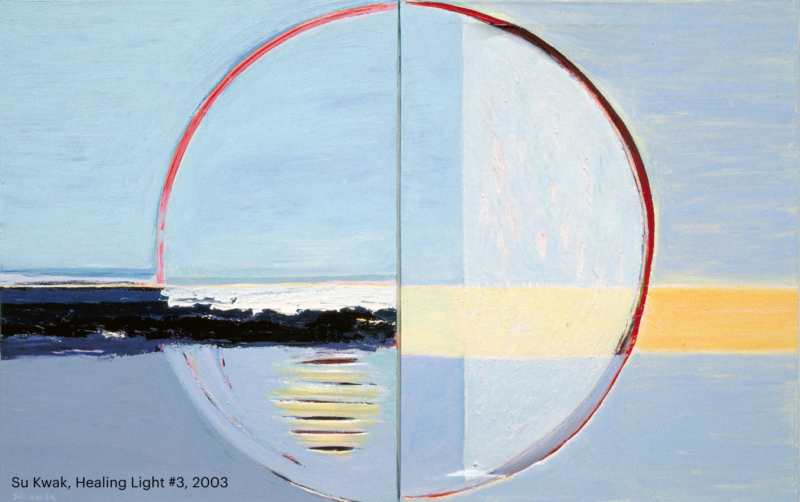Su Kwak, a prominent Asian-American artist, is renowned for her abstract landscapes. Her works have earned a permanent place in prestigious institutions such as the National Museum of Women in the Arts in Washington, D.C., and Korea's National Museum of Modern and Contemporary Art, among others. Fine Art Shippers had the pleasure of speaking with Su Kwak about her incredible artist journey, hope, and light.
Artist Talk: Su Kwak and Her Healing Light
You are originally from South Korea and have lived and worked in the U.S. for many years. What motivated you to move to America?
Su Kwak: I moved to America in 1973— this year marks my 50th in the country. I thought there were more education opportunities here. Encouraged by a friend, I decided to major in art, which I’d always loved. So I attended the University of St. Thomas in Houston. After graduation, the challenge was figuring out how to earn a living. My art professor advised me to pursue graduate studies, as this could give me potential teaching opportunities at colleges or public schools. Following this advice, I enrolled in the graduate program at the University of Chicago.
How was your early artist career developing?
After earning my master's degree, I moved to New York and got a part-time teaching job at the Queens Museum. Its curator Juan Sanchez also introduced me to an artist studio program at Henry Street Settlement, where I started to teach watercolor classes in exchange for a studio space. This job opened many doors for me, leading to my first exhibition at the Queens Museum's annual juried show in 1982 and various group shows across New York.
I then moved back to Chicago. During a visit to the Richard Gray Gallery, the director recommended that I approach the expanding Jan Cicero Gallery. Jan appreciated my work and included me in her upcoming group show. My paintings at that time were inspired by childhood memories in Korea, especially of family visits to our ancestors' tomb sites during the full moon festival in August. One of my works from this series was sold to a collector in Illinois, thanks to that exhibition.
So, overall, there were many happy encounters and kind people who appreciated my art and offered support. I am grateful for all these opportunities, both early in my career and afterward. But, of course, it wasn't just about luck — for those opportunities to arise, I've always worked hard. Art has always been the most important thing for me.
You are such a warm and positive person, one can feel it both speaking with you and looking at your art. I think this is one of the reasons for the happy encounters you talked about.
I’ve always kept going. My most significant solo show in New York also came about thanks to circumstances and the kindness of people. One day, I had plans to have lunch at the Asian Arts Center in New York, but it got canceled, leaving me a bit upset. I spontaneously decided to take the subway downtown to Soho and visit galleries there before heading uptown.
I came across a new gallery, the Denenberg Gallery, which has since closed. I engaged in a conversation with the owner and an artist there, who invited me to their exhibition at the New York Academy of Sciences. Intrigued, I decided to visit it. Afterward, I asked the receptionist about how to organize my show there. She directed me to speak with the director upstairs. I showed her my art, which I always carried with me, and explained that my work focused on space, light, and memories. The director expressed interest—it turned out that due to the unexpected departure of their curator, they were in search of an artist to exhibit in the coming months. Since she liked my works, she offered to arrange my show, which I eagerly accepted.
What kind of art did you showcase at the New York Academy of Sciences?
In the first ten years after graduate school, I experimented with different styles, combining cubist and abstract expressionist ideas, and blending Asian and Western perspectives to create my own visual style. In the early 1990s, I read an article in the Washington Post about how sunlight affects the color of leaves on trees. This inspired me to focus on painting light, as a symbol of hope and positivity. These light-centric paintings were the ones I exhibited at the New York Academy of Science.
As you mentioned, your life wasn't always filled with roses; you worked hard. What challenges did you have to overcome?
Yes, I had a lot of hardships as well. In the early 2000s, my family member in Korea got seriously ill. I traveled back and forth between New York and Korea for several years. Yet, these hardships also nourished my art. This way, I began a new series of paintings called "Healing Light," where I experimented with cutting and then “healing” the canvas, which symbolized new beginnings and hope. One of these paintings was acquired by Korea's National Museum of Modern and Contemporary Art, thanks to the efforts of my dealer at Sun Gallery.
This time in my life also led to the creation of another artwork. While caring for my relative, I couldn't paint, so I drew in my sketchbook. It so happened that a nun from Pauline Books & Media saw it and suggested publishing it as a book titled "Healing Words," combining my sketches with healing Bible verses. The publishers initially wanted new drawings, but I persuaded them to use my original paintings, which would make the book more authentic.
You’ve had so many experiences throughout your life, it’s very inspiring to learn your story and the way you see life in general. One last question for you: what inspires you?
My greatest inspiration is nature, people, and life itself. I just observe things, and when I enter my studio, the memories of what I have seen and experienced resurface, finding their way on canvas. These are the happiest moments in my life.
Interview by Inna Logunova Photo courtesy of Su Kwak


